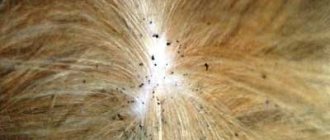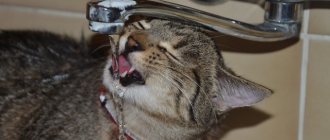Main causes of itching
All causes of itching in cats are divided into several groups.
Ectoparasites
This group includes subcutaneous and cutaneous mites, as well as other blood-sucking parasites. When they appear, dandruff and other flaking appear, hair falls out, and the cat itches until it bleeds.
Severe itching is characteristic of the following diseases:
- Otodectosis. The animal often scratches its ears, face, and shakes its head. As a result of the activity of ear mites, black deposits are noticeable in the shells.
- Sarcoptic mange (pruritic scabies). The cat scratches its neck. If left untreated, the itching moves to the back. Associated symptoms are hair loss at the base of the tail and the appearance of crusts over the body.
- Notoedrosis. The muzzle, back of the head, and brow ridges are susceptible to itching. The animal itches until it bleeds. As a result, the skin becomes rough and thick.
- Cheyletiellosis (wandering scabies). The main symptoms are that the cat itches all the time, and “live dandruff” is noticeable in the tail area. A detailed examination will show that it is not dandruff, but gray skin mites.
- Lice, lice, mites and flea dermatitis. In most cases, fleas and the saliva they secrete are to blame. When infected with them, the cat constantly itches and licks itself. Because of this, hair falls out and bald patches appear.
Allergies
With a food allergy, the cat actively scratches its face and ears, licks and bites its paws. This happens when there is a sudden change in food or the introduction of new foods into the diet. Most often, allergies are caused by insect bites: mosquitoes, wasps, bees, ants.
Interesting! Food allergies in cats often occur when there is a sudden change in food.
Some cat breeds are prone to seasonal allergies. Itching is caused by pollen, house dust, and certain plants. Contact with chemicals and household products also leads to itching and irritation.
Important! Atopic dermatitis cannot be cured. The doctor only prescribes maintenance medications. They reduce symptoms and are given to the animal for the rest of its life.
Contact allergies are a rare type. It occurs when an allergen comes into contact with an animal's skin. As a rule, this is the area of the abdomen and chest. If this type of reaction is suspected, allergy tests are performed.
Skin infections
If your cat is itching but there are no fleas, skin infections may be the cause. They most often join the primary problem. As a result of the activity of bacteria, eczema and weeping wounds develop on the pet's skin. The cat licks them, which causes open wounds.
The development of a fungal disease is indicated by bald areas of the body, peeling and changes in pigmentation. Dermatophytosis manifests itself in individual foci or their connection throughout the body.
Dermatophytosis is characterized by inflammation of the skin in places where it is damaged. These can be insect bites, allergic and neurological wounds. There is redness, swelling or swelling of a certain area on the cat's skin. If an animal scratches its skin vigorously, the temperature of that part of the body rises.
Dry skin
Due to a lack of vitamins A and E in the body, as well as when choosing poor-quality hygiene products, the skin dries out. This process is accompanied by severe itching. First, the cat itches on the sides and back. Then dandruff appears, the skin dries out and cracks in places. The coat does not fall out, but noticeably becomes dull and loses its healthy appearance.
Autoimmune pathologies
Autoimmune pathologies are quite difficult to diagnose and treat. They are characterized by a violation of the body's immune system. As a result, protective cells perceive their own cells and tissues as foreign and attack them.
Important! Discoid lupus erythematosus occurs most often in dogs and is extremely rare in cats.
Such pathological processes are characteristic of diseases:
- Discoid lupus erythematosus. It is characterized by the sudden appearance of wounds and other injuries on the body. In this case, antimicrobial drugs do not give results. Immunosuppressants and glucocorticoids are effective in suppressing this process.
- Jacobs ulcer. This is truly a cat disease. It is characterized by the appearance of a sore on the upper lip of the animal. At first it is a small bubble. Then it turns into an ulcer. If left untreated, teeth and gums become exposed. Antibiotics and wound-healing drugs do not give results.
- Pemphigus foliaceus. The cat itches to the point of sores in the face area. Infections and bacteria often penetrate into scratching areas. This leads to tissue inflammation and the appearance of crusts.
Psychogenic factors
Cats do not tolerate stressful situations well. And at the slightest nervous tension there is a risk of psychogenic itching. The animal begins to chew its tail or itch. In this way the pet calms itself. Soon a dependence on this process arises.
Interesting! Diagnosing psychogenic itch is a complex process. It is determined by excluding other possible causes.
Other reasons
When there are hormonal imbalances, the cat constantly itches and licks. These symptoms are characteristic of the following pathologies.
- Thyroid gland dysfunction. Additionally, hair loss, dullness, dandruff and itching are noted.
- Diabetes. With this disease, cats experience partial hair loss, dullness, dryness, and seborrhea.
- Cushing's syndrome. Improper functioning of the adrenal cortex leads to loss of skin elasticity. Comedones appear on the back and sides.
Cats often itch due to ear infections. Itchy places are the ears, neck and head. With otitis media, discharge containing pus or wax appears from the ears. Marginal seborrhea affects only the tips of the ears. Outwardly, they lose their previous shape, look ugly and unkempt. A bacterial infection is often associated.
Interesting! The most common sign of ear disease is a cat constantly shaking its head.
In the tail area, cats will often wash and lick themselves when the paraanal glands are blocked. The animal can sit and move its butt along the floor. This problem occurs due to poor nutrition. Similar symptoms are characteristic of helminth infection. Determining the exact diagnosis is carried out by exclusion.
Possible disease
Allergy
This is a common disease, but it is not immediately diagnosed. The main signs include: hair loss, dandruff, otitis media, unpleasant odor from the mouth and hair, scabies, sores, wet armpits. At the same time, the cat chews its paws, rubs its nose, and vigorously licks itself.
Causes of allergies:
- dust, mold, pollen;
- Food;
- flea remedies;
- medical supplies;
- hygiene products;
- infection;
- insect bites;
- reaction after vaccination;
- low-quality material (toys, bedding, drinking bowl);
- breed tendency.
When introducing a new product into the diet or skin and coat care products, it is necessary to monitor the pet's behavior. Food allergies manifest as inflammation around the head, anus, and ears. Vomiting and diarrhea occur.
What should the owner do if the cat is itching and licking?
Owners are usually alarmed if a domestic cat frequently licks and scratches itself. And such problems must be resolved immediately. Otherwise, the animal’s behavior will lead to the appearance of deep wounds and scratching. And they are dangerous due to the penetration of pathogenic fungi and bacteria.
There are many reasons for such symptoms. This means that looking for them on your own is pointless and even dangerous. In order not to waste time, the best solution is to contact a veterinarian.
Important! The maximum allowable help from the owners is to treat the pet for worms and fleas. If the animal continues to itch all the time, you need to contact a veterinarian.
Ringworm and other fungal skin infections in cats
Trichophytosis (ringworm)
Take a close look at the areas where your cat scratches most frequently. If there is no hair there, and the bald patch resembles a circle, then it is ringworm.
Important! The disease is caused by a fungal infection. Is contagious to people! Be sure to start treatment as soon as possible!
At home, lichen can be easily and quickly treated in cats, but in people infected from a sick cat, treatment is more difficult.
Dermatomycoses
Fungal and yeast infections of the skin and fur of cats lead to similar symptoms that greatly annoy your pet.
Not dangerous for people. They are treated with specific therapy, which is prescribed by a veterinarian after examination.
Diagnosis of itching in the clinic
There is a certain diagnostic algorithm if a cat’s skin begins to peel, hair falls out, and other dermatological symptoms are observed - it itches, licks:
- Anamnesis collection. The owner provides information about the cat’s breed and age, nutritional habits, and preventive treatments.
- Itching analysis. The doctor determines whether the skin is itchy all over the body or in certain places. Equally important is the frequency and frequency of symptoms.
- Scrapings from places where the kitten itches most often. It is carried out to determine bacterial and fungal infections.
- Analysis for the presence of skin and subcutaneous parasites.
- Examination of the ears for otitis media, ear mites or seborrhea.
- Elimination diet to identify allergens.
- Exclusion of atopic and other types of allergies in cats.
After the diagnosis is made, treatment for the cause itself is prescribed. Elimination of itching is a secondary focus, so the cat may continue to itch during treatment.
Skin and other inflammations in cats caused by bacteria
Here we will touch only on those processes that provoke itching in different parts of the body and force the animal to scratch itself regularly.
Pyoderma
This is a severe bacterial infection of the superficial, or less often deeper, layer of the skin. The consequences of pyoderma are:
- the cat may go bald;
- become covered with pustules and crusts;
- the animal finds no peace, constantly itches furiously and meows.
Cats of all breeds are equally susceptible to infection, but the risk of complications is more often observed in animals with folds on the body, so the owners of such beauties have to be especially careful.
If the lesion has not affected the deeper layers and there are no complications, then recovery occurs quickly at home, but under veterinary supervision.
Ear infection
Symptoms of otitis media in a cat
Otitis in cats can provoke, in addition to severe pain and depression, a desire to scratch the sore ear with a paw.
The need to eliminate itching by frequent scratching results in the appearance of wounds and cuts, because the cat’s claws are sharp! Complete or partial baldness around the affected ear is also possible.
Treatment depends on whether the otitis media is caused by ear mites or bacteria. Therefore, it is better to visit a veterinarian, he will do a scraping for analysis and prescribe the necessary type of treatment.
Therapy
You cannot treat a cat that is constantly licking and itching on your own. The diagnostics carried out reveal the true reason for this behavior. And based on it, the veterinarian prescribes a certain set of drugs. Therapy is divided into two groups:
- Etiotropic. The action is aimed at eliminating the cause that causes itching. The most effective option.
- Symptomatic. Treatment is aimed at controlling symptoms, particularly itching. It is temporary. Ineffective.
Important! The owner can help the animal if he follows all the veterinarian’s instructions. Stopping or adding medications on your own can cause serious harm to your cat.
Prevention measures
The appearance of itching in cats is provoked by a large number of factors. Some preventive measures can minimize most of them:
- Regularly carry out anthelmintic treatment. Preventing worms 3-4 times a year will protect the animal and people who come into contact with it. For the same reason, raw meat, fish and other animal products are excluded from the cat’s diet.
- Minimize stressful situations for the animal.
- Examine the cat for wounds and abrasions after visiting the street. And if they are found, disinfect them.
- If you need to change food, do it gradually.
- Minimize contact with other animals. It is through contact that infection with skin and subcutaneous parasites occurs.
- Wash your cat's litter box regularly and disinfect it.
If your cat itches until it hurts, then this is a reason to contact a veterinarian. Timely treatment of the animal will relieve it from annoying itching and the risk of complications.










